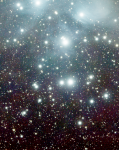Hello Experts,
I have a total exposures of 4 nights, totalling 4 hours of good exposures(after discarding 150+ bad frames) stretched over 4 nights. I have collected 40 darks and 40 flats for each night. I have 200 bias frames.
I have followed this tutorial from start to finish: https://www.lightvortexastronomy.co...rating-and-stacking-images-in-pixinsight.html I assure there is nothing wrong in the pre-processing.
I understand that seeing a green/purple cast is normal when I do a STF, but what I think is not normal is the purple and green blotches in the background. DBE cannot solve it, SCNR cannot solve it, "Markarian's Chain with DSLR " tutorial does not seem to work. I am literally lost
Please help me understand what I am seeing and how it can be corrected.
Thanks in Advance,
AT
I have a total exposures of 4 nights, totalling 4 hours of good exposures(after discarding 150+ bad frames) stretched over 4 nights. I have collected 40 darks and 40 flats for each night. I have 200 bias frames.
I have followed this tutorial from start to finish: https://www.lightvortexastronomy.co...rating-and-stacking-images-in-pixinsight.html I assure there is nothing wrong in the pre-processing.
I understand that seeing a green/purple cast is normal when I do a STF, but what I think is not normal is the purple and green blotches in the background. DBE cannot solve it, SCNR cannot solve it, "Markarian's Chain with DSLR " tutorial does not seem to work. I am literally lost
Please help me understand what I am seeing and how it can be corrected.
Thanks in Advance,
AT


